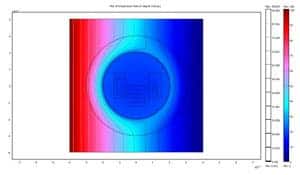Cloaking has turned into a subject of great interest for scientists in the past decade, most likely because of its military potential. We’ve seen some exciting prototypes developed, from optical invisibility cloaks to temporal cloaks, and now French scientists at the University of Aix-Marseille have added a new member to the cloaking family, one that renders heat invisible.

Whereas cloaking research so far was concerned with manipulating wave trajectories, like electromagnetic, sound, elastodynamic or hydrodynamic waves, the French researchers, lead by Sebastien Guenneau at Centre National de la Recherche Scientifique (CNRS), focused on the physical phenomenon of diffusion, rather than wave propagation.
“Our key goal with this research was to control the way heat diffuses in a manner similar to those that have already been achieved for waves, such as lightwaves or sound waves, by using the tools of transformation optics,” Guenneau said.
The researchers devised a mathematical model which proves a set of concentric rings, each made out of different materials of varying diffusion coefficients, can cloak heat. Arranging the materials, the heat was found to flow centrally, so that heat diffuses around an invisibility region, which is protected from heat. Thus, an infrared camera wouldn’t be able to pick up the object since there is no temperature difference between that region and the ambient.
“Heat isn’t a wave — it simply diffuses from hot to cold regions,” he said. “The mathematics and physics at play are much different. For instance, a wave can travel long distances with little attenuation, whereas temperature usually diffuses over smaller distances.”
Thermal cloaking of man-sized objects wasn’t attempted yet, though. Instead, the researchers focused on micro-sized objects for which their mathematical model was conceived. However, this is in the size range of most electronic components, where thermal cloaking might have a tremendous impact by improving cooling. Also, the ability to concentrate heat could prove useful to the solar industry. Of course, scaling the model to larger sized objects will be attempted in the future.
The findings were reported in the journal Optics Express.
[source Photonics]
Was this helpful?



